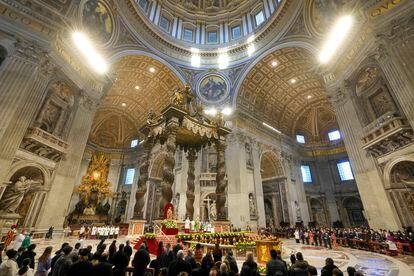An image of the Basilica of San Pedro, in the Vatican, on January 23. Andrew Medichini (AP)
In today's modern world, the market for jewelry of all kinds such as synthetic diamonds, bracelets, earrings or rings made from breast milk or ashes after cremation is growing.
There are those who see in the birth of these jewels made of human material the resurgence of ancient religious relics, which could become the new relics of a secular and secularized world.
The trafficking of relics of all kinds carried out in the Catholic Church during the Middle Ages until today cannot be reduced to a simple superstition but to something that is intimately related to the search for the sacred. This led to excesses that some Popes sometimes encouraged and others criticized.
The theme of relics was always present in the Church as a way of possessing a part of the body of the saints or of objects used by them, which, at the same time, led to the most strange and amazing stories such as the one that still exist today in the churches and cathedrals of different countries the same relics related to the persons of Jesus and his mother Mary. Only in the churches of Rome can you venerate straw and wood from the manger of the newborn Jesus, the column of the flagellation, the crown of thorns and various utensils used at the last supper, as well as vials with the milk of his mother Mary.
Some famous cathedrals in the world such as Cologne in Germany or Chartes in France were built to house the bodies of the Magi, as is the case with the first of these churches, and the tunic of the Virgin Mary, in the second. . There are also various curious relics scattered around the world, such as the foreskin of Jesus. The one that existed in Italy was located in the small medieval town of Calcata, a few kilometers from Rome, and in 1983 it was the subject of a worldwide scandal because one day the parish priest announced that the famous relic to which several miracles were attributed each year “had disappeared ”. I remember that when I questioned the people of the place who were enraged, they then told me that the famous relic had been sold by the priest to some American tourists for 1.000 dollars and that in the locket he had placed a false foreskin that no longer worked miracles.
One of the most famous relics of the Church were, however, the vials that arrived, apparently from the Holy Land, containing milk from the Virgin Mary, which were passed from one king to another, which led Saint Bernardino of Siena to ironize saying that "not even that the Virgin was a cow". And one of the relics in Spain, an arm of Saint Teresa of Ávila, was criticized because it was in the bedroom of the dictator, Francisco Franco, and not in a Church.
The topic of relics is not limited to the Catholic Church. In Islam, for example, hairs from the beard of the prophet Maoma are preserved and it is that today's secularized world and the growth of atheism, often caused by the excesses of the Church, considers the issue of relics as a mere devotion of blessed. And yet, at the same time, the modern market for jewelery with breast milk or genetic material from loved ones is growing, evoking the need for a certain eternalization of life.
This coincidence of the
boom
in secular relics today with a world that is increasingly skeptical of the sacred leads experts in the history of religions to reflect. Reflection and questioning about whether the desire for eternity and the need for the sacred were something that goes beyond beliefs and reaches the essence of the need to want, at all costs, to perpetuate the feeling of mystery. In fact, it was this search for the mystery and anxiety in the face of death that created the first religions as a way of trying to answer the question that even today's most advanced science and technology are not yet capable of answering, such as whether there is or not something beyond death.
Despite all the fair criticism leveled at the Church with the trafficking of relics of the saints, it is possible that the birth of modern jewelry with breast milk is revealing that despite the great advances in science and the beginning of the conquest of the cosmos, Homo sapiens continues to need something related to the afterlife.
And it is that everything absurd that certain religious practices entail can and should be demystified, but it is undeniable that after the death of the gods the human being that we know today, from the most enlightened to the most illiterate, continues to hang in the difficult dilemma to decipher not only about our own existence, but about everything related to what until now we have still been unable to reveal about the mystery of life and death.
Subscribe here to the EL PAÍS América
newsletter
and receive all the key information on current affairs in the region

